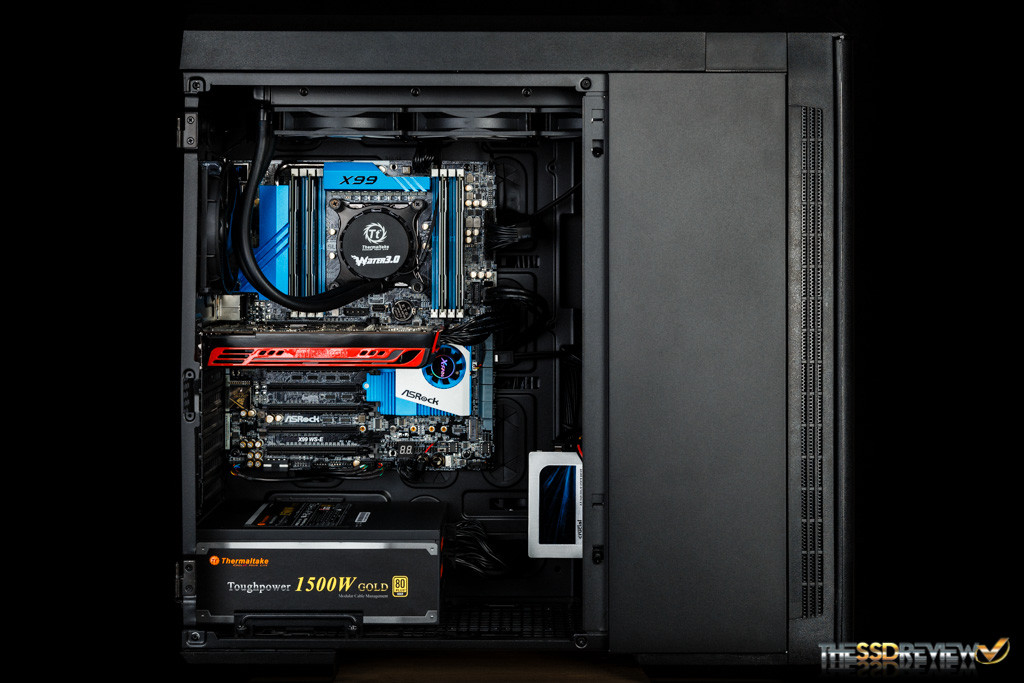TSSDR TEST BENCH AND PROTOCOL
Our testing focus here today is on the storage aspects of the ASRock X99 WS-E. Our goal is to test in a system that has been optimized with our SSD Optimization Guide. To see the best storage system performance possible the CPU C states have been disabled, C1E support has been disabled, Enhanced Intel SpeedStep Technology (EIST) has been disabled. Benchmarks for consumer testing are also benchmarks with a fresh drive so, not only can we verify that manufacturer specifications are in line but also, so the consumer can replicate our tests to confirm that they have an SSD that is top-notch. We even provide links to most of the benchmarks used in the report.
SYSTEM COMPONENTS
This Test Bench build was the result of some great relationships and purchase; our appreciation goes to those who jumped in specifically to help the cause. Key contributors to this build are our friends at ASRock for the motherboard and CPU. Also, a big thank you to Thermaltake for the case. We have detailed all components in the table below and they are all linked should you wish to make a duplicate of our system as so many seem to do, or check out the price of any single component. As always, we appreciate your support in any purchase through our links!
| PC CHASSIS: | Thermaltake Urban T81 |
| MOTHERBOARD: | ASRock X99 WS-E |
| MEMORY: | Crucial Ballistix Sport DDR4 2400MHz |
| CPU: | Intel Xeon E5-2690 V3 |
| CPU COOLER: | Thermaltake Water 3.0 Ultimate |
| POWER SUPPLY: | Thermaltake Toughpower 1500W Gold |
| GRAPHICS CARD: | XFX Radeon HD 5770 |
| STORAGE: | Crucial MX200 |
| OS: | Windows Server 2012 R2 |
| Intel SATA Driver | 13.1.0.1058 |
BENCHMARK SOFTWARE
The software in use for today’s analysis is typical of many of our reviews. To keep things simple we chose to only use Crystal Disk Mark to show the storage performance of this board. We will cover the SATA, M.2, and USB 3.0 performance in this section.
SATA THROUGHPUT
To test the SATA throughput we are going to take a close look at both the Intel SATA ports as well as the Marvell. Our main test SSD will be a 500GB Samsung 850 EVO. For testing the full bandwidth of the Intel RAID ports we will be utilizing a few different SATA 6Gb/s SSDs which all have read and write speeds over 500MB/s, so there should be no issues there. When testing RAID 0 performance we set the strip size to 128KB and enabled write back cache.
INTEL NON-RAID CAPABLE PORTS
The first result on the non-RAID capable SATA ports shows that most performance is where it should be, however, the 4K read and write is drastically lower than what it could be. Taking a look at the results from the RAID capable ports goes to prove it, there is a 50% loss in 4K QD1 speed.
Overall, single SSD performance is about on par with our Z97 test bench on the Intel RAID ports, but falls behind slightly on the non-RAID capable ports.
When testing the total throughput of the SATA RAID connection we found that it is limited to PCIe 2.0 x4 speeds as expected. The best performance from five SSDs in RAID 0 resulted in 1582MB/s read and 1277MB/s write.
MARVELL AHCI MODE
MARVELL RAID MODE
The Marvell SATA throughput results weren’t too surprising to this reviewer. As the link speed from the Marvell 9172 controller is limited to 5Gb/s in reality, you will get results similar to these shown. The highest read speed we were able to reach was 367MB/s while the highest write was 269MB/s. What was quite interesting to find out however was that when the SATA mode was set to RAID we were able to achieve 4K read speeds that are 50% faster than when the SATA mode was set to AHCI. Since the ports allow the SSD to be used as a single drive in the system when the SATA mode is set either way, we suggest that if you do use the Marvell ports, use them with the SATA mode set to RAID.
 The SSD Review The Worlds Dedicated SSD Education and Review Resource |
The SSD Review The Worlds Dedicated SSD Education and Review Resource | 


I respect that ASRock offered a solution to the small business users, selling this kind of boards is not easy, these aren’t boards that everyone needs, more marketing effort is needed.
– Thanks to PLX this board is extensible – here two SAS, data transfer is excellent while simultaneously having OpenCL load on dual graphic.
– It can run Xeon with or without ECC/REG memory, if used without ECC/REG overclock is easier, although some ECC/REG memory can be tweaked by lowering latency – so result is the same.
I don’t like too many integrated stuff on board (e.g Marvel, SAS) because replacement of board becomes expensive, and the choice is limited then. I find WS-E or 10G to have just enough extensiveness for business users, and the price is perfect. We’ve been using ASRock boards long time in 24/7/many years, and with decent memory, no crashes, no reboots needed ever. Good work ASRock.
Small hint: make sure that south-bridge fan is clean and operating perfectly, dust safe cases can help. I wish they made bigger sink with detachable fan blades for easyer maintenance !
Where do I buy the TDM module from? I haven’t found it anywhere… (in Europe)